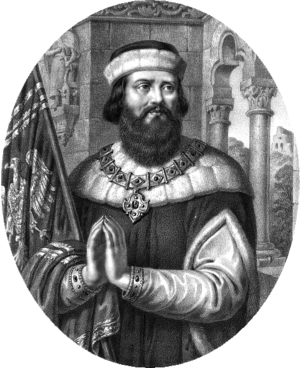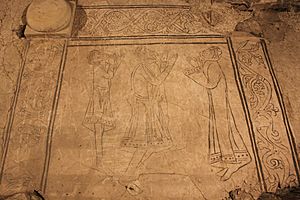Casimir II the Just facts for kids
Quick facts for kids Casimir II the Just |
|
|---|---|
 |
|
| High Duke of Poland | |
| Tenure | 1177–1191 1191–1194 |
| Predecessor | Mieszko III the Old |
| Successor | Leszek I the White |
| Duke of Masovia | |
| Tenure | 1186–1194 |
| Predecessor | Leszek |
| Successor | Leszek I the White |
| Born | 28 October 1138 |
| Died | 5 May 1194 (aged 55) Kraków |
| Burial | Wawel Cathedral, Kraków |
| Spouse | Helena of Znojmo |
| Issue more... |
Adelaide Leszek I the White Konrad I of Masovia |
| House | Piast dynasty |
| Father | Bolesław III Wrymouth |
| Mother | Salomea of Berg |
| Religion | Roman Catholic |
Casimir II the Just (Polish: Kazimierz II Sprawiedliwy) was an important ruler in Poland. He was born on 28 October 1138 and died on 5 May 1194, at 55 years old.
Casimir was a duke in different parts of Poland. He ruled Wiślica from 1166 to 1173, and Sandomierz after 1173. In 1177, he became the ruler of Kraków and the most powerful duke in Poland, known as the High Duke of Poland. He held this position until his death, except for a short time when his older brother, Mieszko III the Old, took over.
In 1186, Casimir also became the Duke of Masovia. He was part of the Piast dynasty, a very old Polish royal family. The name "the Just" was given to him much later, in the 1500s.
Contents
Casimir's Early Life
Casimir was the sixth son of Bolesław III Wrymouth, who was a Duke of Poland. His mother was Salomea of Berg. Casimir was born in 1138, on the same day his father died. Because of this, he was not included in his father's will and did not inherit any land.
For his first few years, Casimir and his sister Agnes lived with their mother in her lands around Łęczyca. They were far from the fights between his older brothers, Bolesław IV the Curly and Mieszko III the Old. These brothers were fighting their oldest half-brother, Władysław II the Exile, who wanted to rule all of Poland. Władysław II was eventually forced out in 1146.
Casimir's mother died in 1144. After that, his older brother Bolesław IV took care of him. Even though he was safe, Casimir still didn't have any land of his own. When he turned 13 in 1151, which was the age to rule some lands, he still had nothing.
Things got worse in 1157. The Emperor Frederick Barbarossa attacked Poland to help Władysław II's sons. As part of a peace deal, Casimir was sent to Germany as a hostage. This was to make sure his brother Bolesław IV stayed loyal to the Emperor. We don't know much about Casimir's time there. He returned to Poland before May 21, 1161, because he is mentioned in a document with his brothers on that day.
Becoming a Duke at Wiślica
In 1166, Casimir's brother Henry died in a battle during a Prussian Crusade. Henry had no children and left all his lands, the Duchy of Sandomierz, to Casimir. However, the High Duke Bolesław IV decided to split the land into three parts. He kept the largest part, gave some to Mieszko III, and only gave the small area of Wiślica to Casimir.
Casimir was very upset. He rebelled against the High Duke with the help of his brother Mieszko and other important people. Casimir had support from most of Lesser Poland. But Bolesław IV quickly stopped the rebellion. In the end, Casimir only kept Wiślica.
In 1172, Mieszko III rebelled again and tried to get Casimir to join him. For some reason, Casimir did not join this time.
Bolesław IV died in 1173. His oldest surviving brother, Mieszko III the Old, became the new High Duke. Mieszko decided to give the entire Sandomierz duchy to Casimir. So, Casimir finally got the lands his brother Henry had wanted him to have.
Revolt Against Mieszko III the Old
Mieszko III was a very strong and strict ruler. This made many nobles in Lesser Poland unhappy. In 1177, a new rebellion started, and it had a good chance of winning. The rebellion included important nobles, the Bishop of Kraków, Mieszko's oldest son Odon, and Duke Bolesław I the Tall of Silesia. Casimir also joined this rebellion, even though he had made peace with Mieszko earlier. We don't know why he joined.
The fight for power was unusual. Mieszko III was surprised by the rebels in his lands and went to Poznań. He fought there for almost two years against his own son Odon. Finally, Mieszko was defeated and had to run away.
Duke Bolesław the Tall tried to take Kraków but got stuck in a fight with his own brother and son in Silesia. He asked Casimir for help. After helping in Silesia, Casimir marched to Kraków and took control quickly. Casimir, now the Duke of Kraków, made a deal. Bolesław the Tall got full control over Lower Silesia. In return, Casimir gave some lands in Lesser Poland to Mieszko I Tanglefoot, as a gift for Casimir's godson, Casimir I of Opole.
High Duke of Poland
The rebellion in 1177 was a big success for Casimir. He took Kraków, became the High Duke, and gained control over many other parts of Poland. This included Silesia, Greater Poland (ruled by Odon), and Masovia and Kuyavia (ruled by young Duke Leszek, who was under the care of Casimir's supporters). On the Baltic Sea coast, Pomerelia was ruled by Duke Sambor I, who was loyal to Poland.

Mieszko III the Old worked hard to get his power back. He went to Bohemia, Germany, and Pomerania for help. To make sure his family would always rule Kraków, Casimir called a meeting of Polish nobles at Łęczyca in 1180. He gave special rights to nobles and the Church. He removed a tax on Church profits and gave up his rights to lands of dead bishops. By doing this, he got them to agree that his family could inherit the throne of Kraków. It would still take over a hundred years for Poland to have a king again.
However, in 1181, Mieszko III, with help from Duke Sambor's brother Mestwin I, took back lands in eastern Greater Poland. He also convinced his son Odon to join him. At the same time, Duke Leszek of Masovia decided to leave Casimir's side. He made Mieszko III's son, Mieszko the Younger, the governor of Masovia and Kuyavia. This meant Mieszko the Younger would likely inherit those lands.
Foreign Affairs
For reasons we don't know, Casimir did not react to these events. He focused on keeping his power in Lesser Poland. In 1184, Casimir met with Emperor Frederick Barbarossa. To stop Mieszko III and keep his title as High Duke, Casimir promised loyalty to Barbarossa and paid him a lot of money.
One of the most important parts of Casimir's rule was his dealings with the Russian lands to the east. His first goal as High Duke was to make friends with the Rurik princes in Kiev. These princes had strong ties to earlier Polish High Dukes through marriage. In November 1178, Casimir arranged for his daughter to marry Prince Vsevolod IV of Kiev.
In 1180, Casimir first got involved in Russian matters. He supported Prince Vasylko and his nephew Leszek of Masovia in a fight over the region of Volhynia. The war ended with Vladimir of Minsk taking control of Volodymyr and Brest. Vasylko kept his lands at Drohiczyn.
The rule of Brest was still not settled. It had been given to Prince Sviatoslav, Casimir's nephew. In 1182, a rebellion started against Sviatoslav. Casimir helped him get his throne back. But Casimir soon saw that the situation was not stable. So, he decided to give power to Sviatoslav's half-brother, Roman.
In 1187, Prince Yaroslav Osmomysl of Halych died, leading to a long fight for who would rule next. At first, his younger son Oleg took power, but he was soon killed. Then, Yaroslav's oldest son, Vladimirko, took Halych. His rule was also shaky. Prince Roman of Brest, with Casimir's help, removed Vladimirko and took control of Halych.
Vladimirko ran away to the Kingdom of Hungary and asked King Béla III for help. Béla III sent his army to Halych. Roman escaped to Kraków, and Vladimirko, in revenge, attacked Lesser Poland. However, King Béla III soon decided to take Halych for Hungary. He removed Vladimirko and put his own son, Andrew, in charge. The war continued for two more years. Finally, Casimir helped Vladimirko get his power back in Halych, following orders from Emperor Frederick Barbarossa.
Internal Politics
In 1186, Duke Leszek of Masovia died. Before he died, the sick duke decided to give all his lands to High Duke Casimir. Leszek had promised his lands to his older uncle Mieszko III before. But Mieszko's strict ways made Leszek change his mind and choose Casimir.
Soon after Leszek's death, Mieszko III took the lands of Kuyavia. Casimir could only take Masovia itself. Still, with the Masovian lands, Casimir now ruled over a large part of Poland.
In 1191, while Casimir was busy with Russian affairs, Mieszko III took control of Wawel Castle in Kraków. He took the title of High Duke and control of the main province. He said that Kraków would now be inherited by his own children, and he put his son Mieszko the Younger in charge. The conflict ended peacefully. When Casimir returned from Russia, he got Kraków back without a fight, and Mieszko the Younger went to his father.
Casimir's last major goal was in early 1194. He led a military trip against the Yotvingians, a Baltic tribe. The trip was a great success, and Casimir returned to Kraków in triumph. After a celebration dinner, Casimir died suddenly on 5 May 1194. Some historians think he was poisoned. His oldest son, Leszek I the White, became High Duke. Like his father, Leszek had to face strong opposition from Mieszko III the Old. Casimir was probably buried at Wawel Cathedral.
Casimir had planned to start a university in Kraków and had even begun building it. But his sudden death stopped his plans. The famous Jagiellonian University was not built until 1364 by King Casimir III the Great.
Relations with the Church
During his rule, Casimir was very generous to the Church. He gave a lot of support to monasteries, especially the Cistercian ones. He also helped expand the worship of Saint Florian, whose remains were brought to Kraków by Bishop Gedko.
Marriage and Issue
Between 1160 and 1165, Casimir married Helena (born around 1140-1142). She was the daughter of Duke Conrad II from a Moravian branch of the Přemyslid dynasty. They had seven children:
- Maria (later called Anastasia) (born before 1167), married Prince Vsevolod IV of Kiev in 1178.
- Casimir (born around 1162 – died 1167), named after his father.
- Bolesław (born around 1168/71 – died 1182/83), probably named after his grandfather Bolesław III Wrymouth. He died by accident after falling from a tree. He was likely buried at Wawel Cathedral.
- Odon (born 1169/84 – died as a baby).
- Adelaide (born around 1177/84 – died 1211), who founded a convent in Sandomierz.
- Leszek I the White (born around 1184/85 – died 1227).
- Konrad (born around 1187/88 – died 1247).
See also
 In Spanish: Casimiro II el Justo para niños
In Spanish: Casimiro II el Justo para niños



